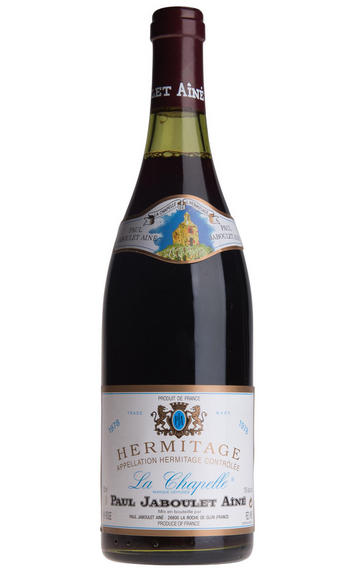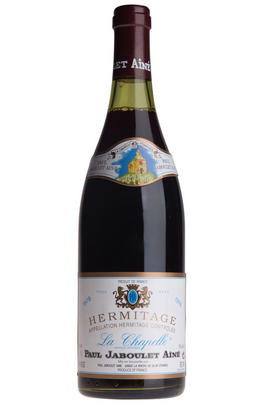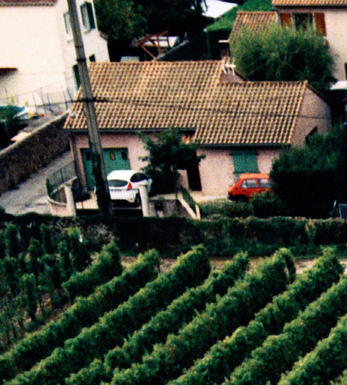
2009 Hermitage, La Chapelle, Paul Jaboulet Aîné, Rhône

Critics reviews
One needs no further evidence of the extraordinary turn around in the quality of the Jaboulet wines than what proprietress Caroline Frey has accomplished in 2009 as well as 2010. As I indicated last year, this is one of the great qualitative turn arounds in the wine world. It is welcomed by all wine lovers given the historic legacy of the wines of Jaboulet and the importance of this famous firm in all of France.
Ms. Frey, who is also responsible for the brilliant wines produced at La Lagune in Bordeaux, has reduced the amount of new oak for the red wines to about 20% and to negligible proportions for the whites. A second wine of Hermitage, La Petite Chapelle, is fashioned from 33% or more of the production that is culled out to guarantee that the great reputation of the Hermitage La Chapelle has enjoyed over the last century is maintained.
(Robert Parker - Wine Advocate #198 Dec 2011)
About this WINE

Jaboulet
Paul Jaboulet Aîné is an iconic producer in the Rhône Valley. Founded in 1834 by Antoine Jaboulet (father of Paul), it was Paul’s son Louis and grandson Gérard who can be heralded among the great ambassadors for both the region and the négociant. Upon Gérard’s untimely death in 1997, the business began struggling and was sold to the Frey family in 2005.
Caroline Frey, daughter of owner Jean-Jacques Frey, has been at the helm of winemaking here since 2006. She immediately began converting the estate to sustainable farming, achieving organic certification in 2016. In 2022, Jean-Guillaume Prats, of Bordeaux fame, was brought onboard.

Hermitage
Hermitage is the most famous of all the northern Rhône appellations. The hill of Hermitage is situated above the town of Tain and overlooks the town of Tournon, just across the river. Hermitage has 120 hectares and produces tiny quantities of very long-lived reds.
The vines were grown in Roman times, although local folklore claims their origins to be nearly 600 years earlier. The name ‘Hermitage’ first appeared in the 16th century, derived from a legend of the 13th century Crusade, involving a wounded knight called Gaspard de Stérimberg, who made refuge on the hill, planted vines and became a hermit.
During the 17th century, Hermitage was recognised as one of the finest in Europe. In 1775, Château Lafite was blended with Hermitage and was one of the greatest wines of its day. In the late 19th century, however, Phylloxera wiped out all the vineyards.
The wines are powerful, with a deep colour and firm tannins, developing into some of the finest examples in France, with the potential to age for many decades. The best Hermitage is produced from several climats or more, blended together. The main climats are Les Bessards, Le Meal, L’Hermite, Les Greffieux and Les Diognieres. Most of the finest climats face broadly south, giving maximum sunshine. Most growers only have one or two climats and they might not complement each other; Hermitage quality can therefore vary hugely. Only the top producers have extensive diversified holdings.
80% of the wine produced is red, however up to 15% of white grapes can be used in the blend. Most growers use 100% Syrah and utilise the white grapes to make white wines only. Chapoutier, Jaboulet and Tain l'Hermitage are the principal proprietors of the appellation’s vineyards.
The white wines are made from the Marsanne and Roussanne grapes. Great white Hermitage can age, taking on the fruit characters of apricots and peaches, often giving a very nutty finish. The best examples in great vintages can last 50 years.
Mature red Hermitage can be confused with old Bordeaux. In a blind tasting of 1961 First Growth Clarets, the famous 1961 Hermitage La Chapelle was included. Most people, including its owner, Gerard Jaboulet, mistook it for Château Margaux.

Syrah/Shiraz
A noble black grape variety grown particularly in the Northern Rhône where it produces the great red wines of Hermitage, Cote Rôtie and Cornas, and in Australia where it produces wines of startling depth and intensity. Reasonably low yields are a crucial factor for quality as is picking at optimum ripeness. Its heartland, Hermitage and Côte Rôtie, consists of 270 hectares of steeply terraced vineyards producing wines that brim with pepper, spices, tar and black treacle when young. After 5-10 years they become smooth and velvety with pronounced fruit characteristics of damsons, raspberries, blackcurrants and loganberries.
It is now grown extensively in the Southern Rhône where it is blended with Grenache and Mourvèdre to produce the great red wines of Châteauneuf du Pape and Gigondas amongst others. Its spiritual home in Australia is the Barossa Valley, where there are plantings dating as far back as 1860. Australian Shiraz tends to be sweeter than its Northern Rhône counterpart and the best examples are redolent of new leather, dark chocolate, liquorice, and prunes and display a blackcurrant lusciousness.
South African producers such as Eben Sadie are now producing world- class Shiraz wines that represent astonishing value for money.


Buying options
Add to wishlist
Description
the 2009 Hermitage La Chapelle is easily the greatest, most profound La Chapelle since the 1990. Most of this cuvee comes from Le Meal and Les Bessards vineyards, with a touch of Les Roucoules fruit in the blend. It is an opaque purple-colored wine with enormous concentration in addition to an extraordinary bouquet of graphite, creme de cassis, blackberries, licorice, beef blood and a touch of smoked game. Boasting phenomenal intensity, a full-bodied mouthfeel and 50 years of longevity, the only thing that could possibly hold it back is that most consumers should plan on laying it away for 8-10 years.
One needs no further evidence of the extraordinary turn around in the quality of the Jaboulet wines than what proprietress Caroline Frey has accomplished in 2009 as well as 2010. As I indicated last year, this is one of the great qualitative turn arounds in the wine world. It is welcomed by all wine lovers given the historic legacy of the wines of Jaboulet and the importance of this famous firm in all of France.
Ms. Frey, who is also responsible for the brilliant wines produced at La Lagune in Bordeaux, has reduced the amount of new oak for the red wines to about 20% and to negligible proportions for the whites. A second wine of Hermitage, La Petite Chapelle, is fashioned from 33% or more of the production that is culled out to guarantee that the great reputation of the Hermitage La Chapelle has enjoyed over the last century is maintained.
(Robert Parker - Wine Advocate #198 Dec 2011)
wine at a glance
Delivery and quality guarantee